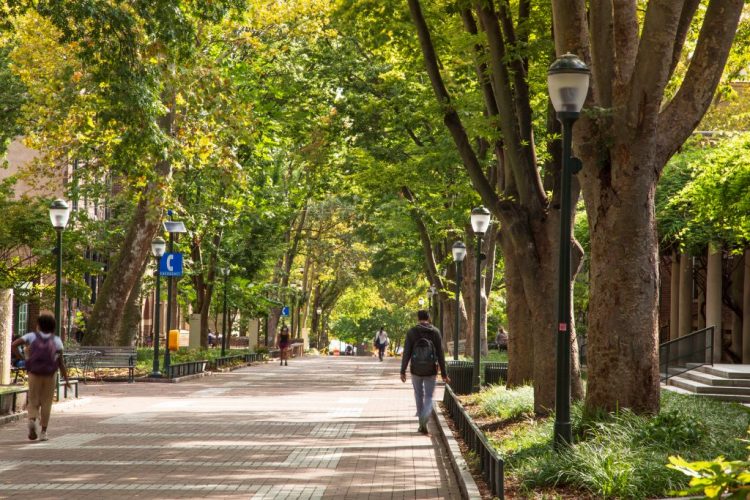As the Supreme Court prepares to hear arguments in a case that could strike down affirmative action in college admissions, researchers are looking at other admissions preferences. A new study calculates the superior enrollment yield and the likelihood of donations from legacy students at one unidentified elite college. Credit: Jumping Rocks/Education Images/Universal Images Group via Getty Images
Elite colleges and universities say they want to diversify their student bodies, and yet they continue to favor white students with certain credentials and fail to keep up with the changing demographics in our country. Despite affirmative action, Black and Hispanic students were more underrepresented at top colleges in 2015 than they were in 1980, though their numbers improved at some elite schools during the pandemic.
One reason: children of alumni. Known as legacy students, these students are up to eight times more likely to be accepted at elite colleges, according to one estimate. In the affirmative action cases currently before the Supreme Court, rarely seen admissions data has been made public and it shows that children of Harvard alumni were accepted at a rate of 33.6 percent in the classes of 2014–19, compared with 5.9 percent for non-legacies, according to a 2021 report in the Boston Globe. As more and more high schoolers apply to top schools, their chances tumble while the acceptance rate for legacies remains constant. The unfairness of it all only seems to grow. And because so few parents of color have graduated from these colleges, legacy admissions remain overwhelmingly white.
To find out why elite colleges love legacies, two business school professors were granted access to 16 years of admissions data at one elite Northeastern college. The upshot: it’s in this school’s clear self-interest to take them. Alumni children who received offers matriculated at much higher rates, giving the school more certainty in their future enrollment numbers. And these loyal families with multi-generational ties to the college were far more likely to donate funds, money that the school needs, in part, to offer scholarships to others.
“We see evidence that the use of legacy admissions comes at the cost of diversity in the student body,” said Ethan Poskanzer, a co-author of the study and an assistant professor at the Leeds School of Business at the University of Colorado, Boulder. “Colleges have different goals in the admissions process, which are to get qualified students, to get students who will be materially supportive, and to increase diversity. Those can be in competition. Legacy admissions is a case where those goals come into conflict with one another.”
Poskanzer’s study, “Through the Front Door: Why Do Organizations (Still) Prefer Legacy Applicants?” was written with Emilio Castilla at MIT’s Sloan School of Management and published in the October 2022 issue of the American Sociological Review.
Poskanzer and Castilla promised to keep the identity of the elite college they studied a secret in order to publish their findings. But they described it as a Northeastern private college that is “representative” of the top 25 schools ranked by U.S. News & World Report. As at other elite schools, the student body is wealthy. Half of the students hail from ZIP codes with mean household incomes over $100,000, a threshold that only 6 percent of ZIP codes in America met during the study period.
More than a third of the legacy students who applied were accepted, compared with only 14 percent of non-legacy students. That added up to almost 3,300 children of alumni accepted during the 16 years that the researchers studied. Legacy students are a major category, rivaling the total number of students of other races and ethnicities. Approximately, 3,500 Black students, 3,100 Hispanic students and 7,300 Asian students were given offers of admission during the time period studied. (There is some overlap between legacy and students of color, but nearly three-quarters of the legacies were white.)
Legacies were much more likely to attend. Of the accepted legacy students, nearly three quarters – 74 percent – agreed to come and enrolled. Fewer than half of the non-legacy students – just 47 percent – matriculated. That’s a giant 27 percentage point difference. The more predictable, better yield that legacies offer allows the college to plan each admissions cycle with more certainty and anticipate future tuition revenues, the authors explained.
Donations, of course, are the other big bonus that legacy students bring. At this college, the alumni engagement office assigned each alumni a score based on how graduates contribute after graduating. It’s unclear exactly how many dollars each point translates to, but legacies had an average “give” score of 48 points, 50 percent higher than the 32 point average of non-legacies.
It’s not that legacy students earned higher wages after graduation. Both groups – legacy and non-legacy – had an average income of roughly $85,000 a year.
Even more potent was the propensity to be a big donor. A whopping 42 percent of legacy graduates were flagged as potential top donors, which could include their whole family. Only 6 percent of non-legacy graduates were flagged as potential top donors.
“Legacies make better alumni after graduation and have wealthier parents who are materially positioned to be more generous donors than non-legacy parents,” the authors wrote.
Academically, legacy applicants tended to have slightly lower high school grades. But the lower achieving legacy applicants were generally rejected. Among the admitted legacies, grades and test scores were indistinguishable from non-legacy students. Both groups had an average SAT score that surpassed 1430. Once on campus, legacy students tended to have slightly higher college grades, but their involvement in campus activities, merit awards, academic recognition and on-time graduation rates were indistinguishable from non-legacy students. In sum, legacy students, on average, were about as academically strong as non-legacy students, neither superior nor inferior.
Of course, there is a downside to legacies. As Poskanzer put it, college admissions is a “zero-sum” game and for every legacy applicant who is admitted, there is one less seat for everyone else. Graduating from these elite colleges can open doors to jobs and change lives.
Admissions officers are not intentionally opting for white students over students of color, but they have conflicting pressures. One goal is to pick a diverse class, but they are also tasked with selecting students who will come and who will support the school financially thereafter. Legacy students fill those latter two demands.
This story about legacy students was written by Jill Barshay and produced by The Hechinger Report, a nonprofit, independent news organization focused on inequality and innovation in education. Sign up for the Hechinger newsletter.
Related articles
The Hechinger Report provides in-depth, fact-based, unbiased reporting on education that is free to all readers. But that doesn’t mean it’s free to produce. Our work keeps educators and the public informed about pressing issues at schools and on campuses throughout the country. We tell the whole story, even when the details are inconvenient. Help us keep doing that.
Source by hechingerreport.org










